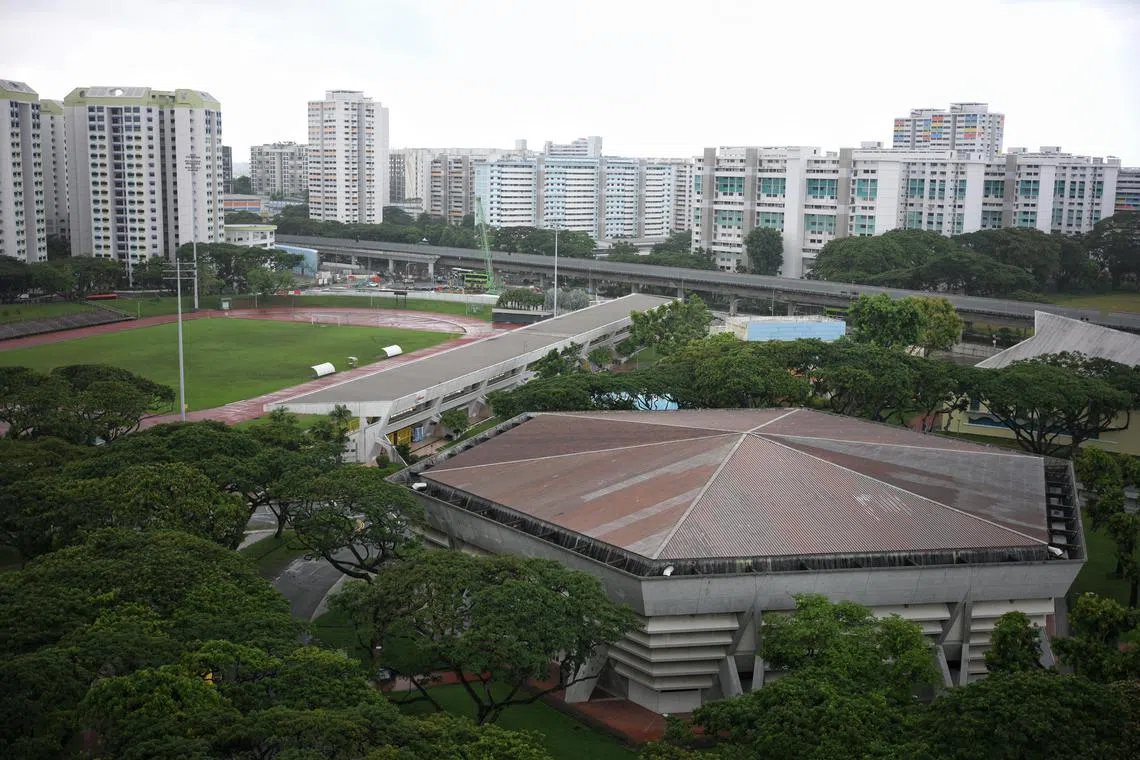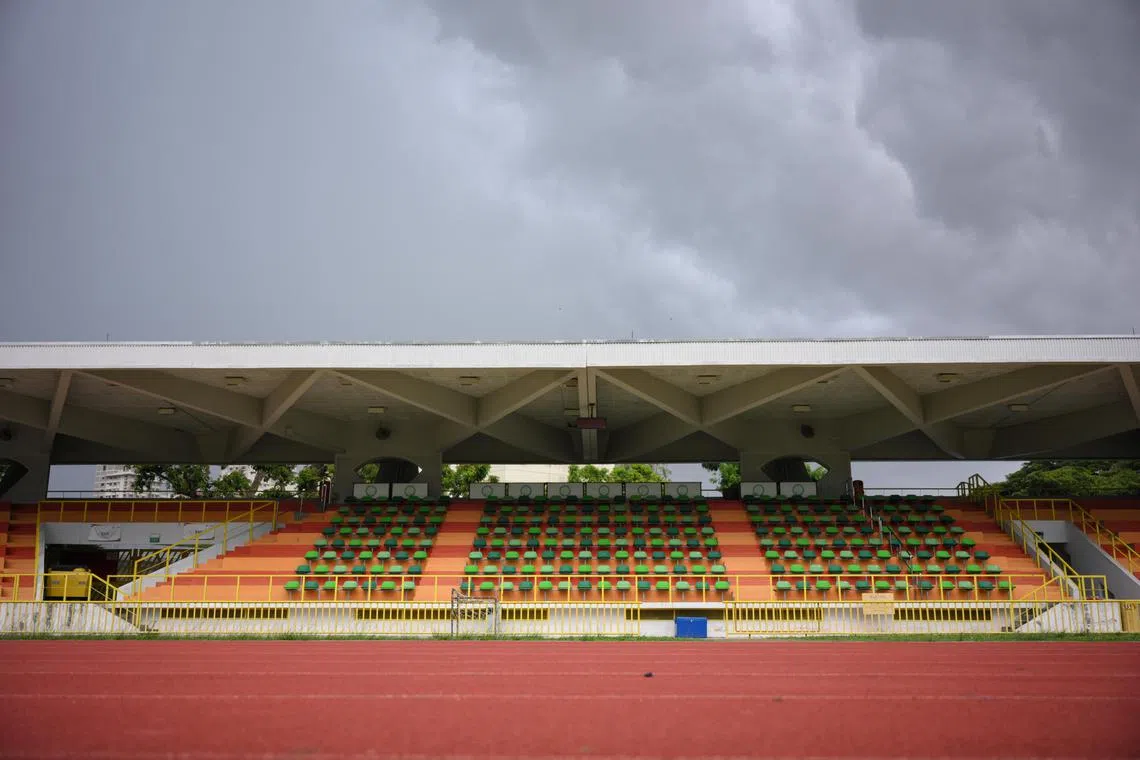Plans to redevelop Bedok Stadium being studied
Sign up now: Get ST's newsletters delivered to your inbox

The Bedok Stadium (left) is part of Bedok Sports Complex, which opened in stages from the early 1980s.
ST PHOTO: MARK CHEONG
Follow topic:
SINGAPORE – The authorities are studying the potential redevelopment of Bedok Stadium, the only stadium in the east operated by national sports agency Sport Singapore (SportSG).
At an ongoing roving exhibition
The authorities’ plans to potentially redevelop the stadium were presented from May 11 to 19 at one of the exhibition’s stops at Bedok Town Square, which showcased plans for the east region.
Asked for more details about the plans, such as when the studies will be completed and what a redeveloped stadium may include, SportSG and URA told The Straits Times on May 18 that the agencies are seeking public feedback on “possible future recreational facilities and exploring various opportunities for the east region, including Bedok Stadium”.
“More details can be shared only when ready,” they said.
The stadium is part of Bedok Sports Complex, which opened in stages from the early 1980s.
Heartbeat@Bedok, a nearby integrated development that opened officially in 2018, took over many of the complex’s public sporting functions.
Heartbeat@Bedok houses several facilities run by SportSG, such as a gym, a swimming complex, a tennis centre and a sports hall for activities such as badminton.
What remains at the sports complex’s original location in Bedok North Street 2 are the stadium, a tennis centre that takes only corporate bookings and three blocks.
One of the blocks – the old Bedok Sports Hall (Block 3) – houses the Singapore Weightlifting Federation, the Wrestling Federation of Singapore and the Singapore Boxing Federation.
Block 7 is occupied by the Singapore Wushu Dragon and Lion Dance Federation and the Singapore Taekwondo Federation. Block 5 is empty.
Also part of the sports complex was Bedok Swimming Complex, which was demolished after it closed in July 2017. Six new basketball courts – two sheltered and four outdoor – are slated to open on the site later in 2024.
While URA and SportSG did not say where the stadium, if redeveloped, may be sited, URA’s 2019 masterplan indicates that a site of about 3.4ha – where the tennis centre and the upcoming basketball courts sit – is zoned for sports and recreational use.

7 Bedok North Street 2 houses the Singapore Wushu Dragon and Lion Dance Association and the Singapore Taekwondo Federation.
ST PHOTO: MARK CHEONG
Meanwhile, the 7ha site that the stadium and the three blocks now occupy is zoned for residential use, with a gross plot ratio of 3.5. Gross plot ratio refers to the amount of development permitted for a site.
Architectural historian Yeo Kang Shua, a Bedok resident who runs at Bedok Stadium, noted that it is the only public sports facility in the east with an eight-lane running track, making it a popular venue for schools hosting their track and field days.
Hence, redeveloping the stadium may inconvenience many schools, said the 48-year-old, adding that the absence of running track options in the area also makes the stadium popular with the public.

The hexagonal-shaped old Bedok Sports Hall, which houses several national sports associations.
ST PHOTO: MARK CHEONG
Geotechnical supervisor Jasim Uddin, 35, commutes weekly to the stadium from Kaki Bukit, where he lives, to do interval training at the track.
He said that given the lack of eight-lane tracks in the east, Bedok Stadium is one of only two training venues for him – the other being the Singapore University of Technology and Design in Upper Changi.
“Just increasing the number of shower facilities and toilets will do at the current stadium.”
He added that should redevelopment be pursued, a sheltered running track – like the one at the National Stadium in Kallang – would allow him to continue training on rainy days.
Mr Fa’iz Malik, who runs at Bedok Stadium once or twice a week, hopes that the stadium will not lose the eight-lane track as the former Tampines Stadium did when it made way for integrated development Our Tampines Hub.
Mr Fa’iz, who works in sport events management, said the Tampines facility’s partially sheltered running track is not suited to the needs of many athletes because of its irregular shape and length.
The 39-year-old added that if refurbishment is done instead of redevelopment, the grandstand at Bedok Stadium – which he said has become rundown – could be spruced up and made wheelchair-accessible.

Regular users of Bedok Stadium said its grandstand could do with an upgrade.
ST PHOTO: MARK CHEONG
Dr Yeo hopes the authorities will consider conserving the old, hexagonal-shaped Bedok Sports Hall, if the site is redeveloped.
The building, he said, has a unique structure, achieved by having four pairs of inclined columns at each of the hall’s six corners.
Dr Yeo noted that the hall is the third Housing Board-built indoor sports hall, with the first in Toa Payoh being redeveloped into an integrated development which reopened in 2023

The old Bedok Sports Hall was the third indoor sports hall to be built by the Housing Board.
ST PHOTO: MARK CHEONG
Photographer Gareth Phua, a Bedok resident since the 1990s, said redeveloping the stadium is likely to “change the feel of Bedok”.
Mr Phua, 53, who documented Bedok Swimming Complex on the last day of its operations and its subsequent demolition, said Bedok Sports Complex had facilities spread over a wide area, such that its structures were “not humongous and not imposing” in the way that integrated facilities such as Heartbeat@Bedok appear to him.
He hopes an eight-lane track will still feature in the stadium if it is redeveloped.
“Nothing can replace running around on an open field or on the track, and there is only that much you can do on a stair-climbing machine or stationary bike,” he added.
Dr Yeo and Mr Phua said the stadium has accrued social memories over the decades, adding that it has been a popular venue for general election rallies because of its size.
Mr Fa’iz noted that it is also popular with many seniors who gather for morning exercises.
Shortly after its opening, the stadium was one of six locations for decentralised National Day celebrations in 1983.
Besides Bedok Stadium, URA also wants ideas for the Paya Lebar Air Base (PLAB) site and the Long Island project
Citing the former Stapleton airport in Denver, Colorado, which has been repurposed into an entertainment venue and brewery, a panel at URA’s exhibition said PLAB’s terminal and control tower could be used as a bowling alley, arcade and restaurant, or even an aviation-themed brewery.
Ideas to repurpose a train shed at Changi Depot for temporary community uses are also being sought, with URA showing examples of other projects overseas, such as the Hin Bus Depot in Penang and Carriageworks in Sydney, both used as arts spaces.
To provide feedback and find out more about the recreation masterplan, visit go.gov.sg/Recreation
Recreation masterplan roving exhibition stops
VivoCity (May 21 to June 2)
Kallang Wave Mall (June 8 to 16)
One Punggol (June 22 to 30)
Canberra Plaza (July 6 to 14)
The URA Centre (July 18 to 27; closed on Sundays)


